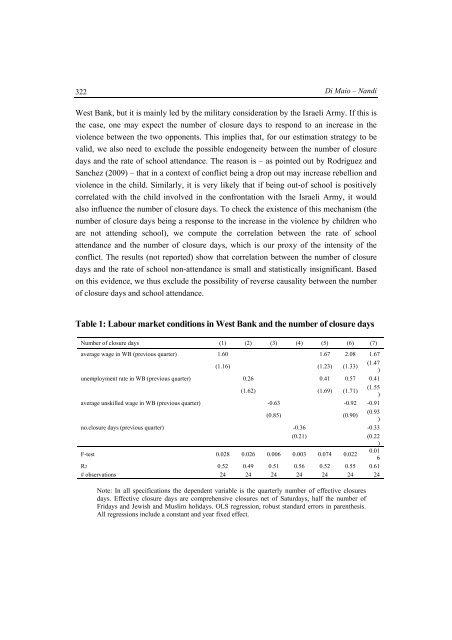The Palestinian Economy. Theoretical and Practical Challenges
The Palestinian Economy. Theoretical and Practical Challenges
The Palestinian Economy. Theoretical and Practical Challenges
You also want an ePaper? Increase the reach of your titles
YUMPU automatically turns print PDFs into web optimized ePapers that Google loves.
322<br />
Di Maio – N<strong>and</strong>i<br />
West Bank, but it is mainly led by the military consideration by the Israeli Army. If this is<br />
the case, one may expect the number of closure days to respond to an increase in the<br />
violence between the two opponents. This implies that, for our estimation strategy to be<br />
valid, we also need to exclude the possible endogeneity between the number of closure<br />
days <strong>and</strong> the rate of school attendance. <strong>The</strong> reason is – as pointed out by Rodriguez <strong>and</strong><br />
Sanchez (2009) – that in a context of conflict being a drop out may increase rebellion <strong>and</strong><br />
violence in the child. Similarly, it is very likely that if being out-of school is positively<br />
correlated with the child involved in the confrontation with the Israeli Army, it would<br />
also influence the number of closure days. To check the existence of this mechanism (the<br />
number of closure days being a response to the increase in the violence by children who<br />
are not attending school), we compute the correlation between the rate of school<br />
attendance <strong>and</strong> the number of closure days, which is our proxy of the intensity of the<br />
conflict. <strong>The</strong> results (not reported) show that correlation between the number of closure<br />
days <strong>and</strong> the rate of school non-attendance is small <strong>and</strong> statistically insignificant. Based<br />
on this evidence, we thus exclude the possibility of reverse causality between the number<br />
of closure days <strong>and</strong> school attendance.<br />
Table 1: Labour market conditions in West Bank <strong>and</strong> the number of closure days<br />
Number of closure days (1) (2) (3) (4) (5) (6) (7)<br />
average wage in WB (previous quarter) 1.60 1.67 2.08 1.67<br />
(1.16) (1.23) (1.33)<br />
(1.47<br />
)<br />
unemployment rate in WB (previous quarter) 0.26 0.41 0.57 0.41<br />
(1.62) (1.69) (1.71)<br />
(1.55<br />
)<br />
average unskilled wage in WB (previous quarter) -0.63 -0.92 -0.91<br />
(0.85) (0.90)<br />
(0.93<br />
)<br />
no.closure days (previous quarter) -0.36 -0.33<br />
(0.21) (0.22<br />
)<br />
F-test 0.028 0.026 0.006 0.003 0.074 0.022<br />
0.01<br />
6<br />
R2 0.52 0.49 0.51 0.56 0.52 0.55 0.61<br />
# observations 24 24 24 24 24 24 24<br />
Note: In all specifications the dependent variable is the quarterly number of effective closures<br />
days. Effective closure days are comprehensive closures net of Saturdays, half the number of<br />
Fridays <strong>and</strong> Jewish <strong>and</strong> Muslim holidays. OLS regression, robust st<strong>and</strong>ard errors in parenthesis.<br />
All regressions include a constant <strong>and</strong> year fixed effect.
















